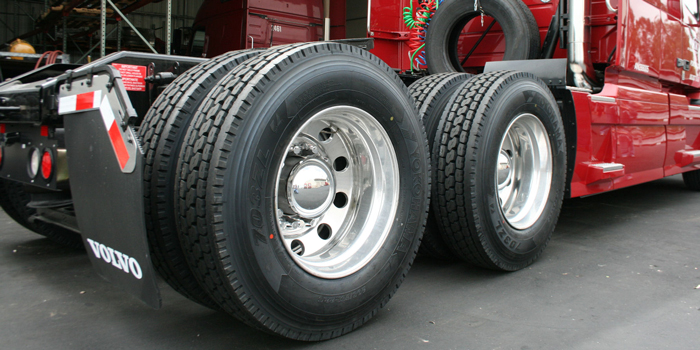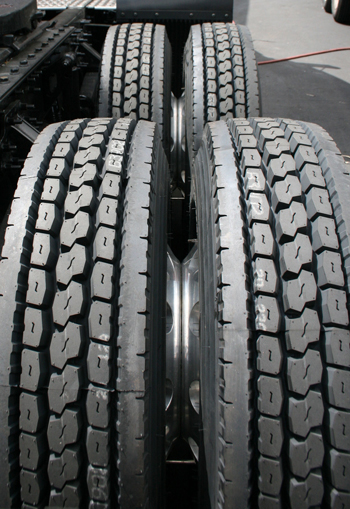
Drive tires are the driving force of commercial vehicles. Whether operating on pavement, gravel, dirt, mud or snow, drive tires are designed for a plethora of harsh environments, offering greater traction and stability compared to other tires. While other types of commercial tires can be used on the drive axles, drive tires are engineered specifically for this position to transform torque into traction.
Why Drive?
“The drive tire’s purpose is to transmit force, transforming torque into tractive force from the tires to the road,” says Matthew Hanchana, sales technical service manager for Giti Tire (USA), which markets and sells GT Radial truck tires in North America. “Lug or block designs help drive tires maximize traction levels on different types of surfaces.”
The lugs are the most distinctive feature of a drive tire and are typically positioned in the center of the tread pattern. However, deep or ultra deep lugs often cause a tire to operate at higher temperatures, leading manufacturers to engineer drive tires with a compound that keeps the tire cool.
One approach manufacturers take to design a tire optimized for the drive axle is using a base compound between the belt package and the tread rubber to keep the tire running cooler, says Walt Weller, vice president of strategic accounts for the China Manufacturers Alliance (CMA).
“This base compound would be designed to dissipate heat as the tire is in operation,” Weller adds. “Other softer compounds could also be used in the tread to provide improved traction.”
Deep tread depths, siping and channels between lugs also come into play to give drive tires excellent traction on various surfaces. Plus, a drive tire’s deep tread depth (normally between 26-32/32nds) tends to provide longer tread life compared to its steer, all-position or trailer tire counterparts.
While added traction is great, there can be downside to the deep tread: poor fuel economy.
“Because drive tires are usually deeper than the other tires on the vehicle they also have the most rolling resistance. In a typical Class 8 truck and trailer, 50% of the tire rolling resistance will be attributed to the drive tires,” notes Rick Phillips, Yokohama Tire Corp.’s vice president of sales.
Due to the fuel effects of a drive tire’s deep tread depth, as tire technology evolves, more and more fuel-efficient and SmartWay-verified drive tires are now on the market so a fleet doesn’t have to sacrifice fuel efficiency for traction.
Application
“You have to get the right tire in the right application,” says Phillips. “Tires are a lot like athletic shoes. If you are running a relay race on an indoor track, you need a different shoe than if you are playing football on a muddy field.”
Like other types of commercial tires, drive tires will perform better in certain applications. Those who need to haul heavy loads on surfaces ranging from pavement to rough terrain, including snow, are normally ideal candidates for drive tires. The heavier tire and deeper tread will help the tire combat the tough terrain and harsh torque from the heavy load.
“If traction is needed in the application, a drive tire is the better choice,” notes Bridney Perry, Continental Tire’s product manager for NAFTA, commercial vehicle tire. “All-position tires tend to have straight ribs that don’t provide much traction. They also tend to be shallower than most drive tires, which won’t last long on the drive axle.”
However, if a truck is hauling light loads and never moves off a paved surface, an all-position tire can still be an option.
Drive tires are also beginning to evolve for even more specific applications like snow or single-drive axle, heavy torque LTL applications.
“For example, the single-drive axle, heavy torque LTL application calls for tires that provide traction, fuel-efficiency and mileage. Many manufacturers have begun designing tires specifically for that application,” Perry says.
Ultimately, asking fleet managers the right questions will help you understand what a fleet needs with a drive tire. Giti’s Hanchana and Continental’s Perry suggest asking the following questions to determine the best drive tire for your customer:
• Where do the trucks go and what will the routes be like?
• Will the vehicle be used on-road, off-road, or both?
• What are they hauling?
• How many miles are they averaging per month?
• Are you looking for fuel efficiency?
• Are you looking for high mileage?
Mileage
Fleets typically want the most out of their tires, and that means they need drive tires that offer great mileage. Drive tires that are well maintained can reach their full mileage potential and be retreaded multiple times, giving the tire a extended life.
Drive tires are often mounted in a dual assembly (if they are not of the wide base tire variety) so it is important to frequently check the air pressure of the inside dual tire. The appropriate air pressure should also be maintained for the life of the tire to maintain the tire casing and ensure long mileage.

“All drive tires require regular maintenance, but tires in severe to off-road service should have air pressure checked regularly as they are more susceptible to punctures and foreign objects,” Conti’s Perry says.
An immense amount of force is applied to the tire in the drive axle. This excessive force can cause tires to degrade faster, meaning dealers and fleets need to inspect for damage more frequently if drive tires operate in severe applications.
“Life expectancy of a drive tire varies depending on the application,” CMA’s Weller notes. “Line haul drive tires typically deliver more tread life in miles than local delivery vehicles or waste/logging/or construction vehicles.”
“Typically, the more severe the application the more frequent the need for replacement tires. Waste-haul vehicles, logging and construction vehicles measure tire life in time such as months, while vehicles used in regional line haul and long haul can have drive tires that are measured in hundreds of thousands of miles and may last two-three years or longer in some cases,” he adds.
It is also critical that dealers pay close attention to drive tires when mounting or rotating tires on a vehicle because some drive tires are directional.
“Directional drive tires are designed to run in a specific direction for the life of the tire. Drive tires should also be rotated when vehicles are serviced,” Perry says. “X-style cross rotation is best; it means moving the front-axle drive tires to the rear axle on the opposite side and vice versa.”
Pairing the right maintenance with the right drive tire will leave your fleets happy with the added mileage and traction drive tires support.












